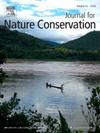Future at risk? Specialized flagship herbivores threatened by climate change in the Atlantic Rainforest
IF 2.5
3区 环境科学与生态学
Q2 BIODIVERSITY CONSERVATION
引用次数: 0
Abstract
Predictive niche modeling studies suggest significant biodiversity loss under climate change scenarios, indicating that species currently classified as least concern may face extinction risks. Here, we assessed two flagship butterfly species endemic to the Atlantic Forest: Arcas ducalis and Cyanophrys bertha. Both species have previously been listed as regionally threatened, and C. bertha is considered ’Vulnerable’ (VU) by the International Union for Conservation of Nature (IUCN), although both are now classified as ’Least Concern’ (LC) by Brazilian government. It remains unclear whether these species are naturally rare or difficult to detect. Assessing the effects of climate change on their conservation status and dispersal potential may help establish more accurate threat categories. This study aimed to evaluate the effects of climate change under two scenarios (SSP245, optimistic; SSP585, pessimistic) for two future periods. The results indicate that A. ducalis may experience a range reduction of over 46%, with a decline of more than 40% in interaction with one of its host plants under the pessimistic scenario. Conversely, C. bertha could be classified as ’Near Threatened’ (NT) due to a range reduction of over 66% and a decrease of more than 89% in interaction with one of its host plants in the same scenario. Representation within Conservation Units (CUs) suggests that both species will maintain adequate range coverage only under current conditions, with significantly reduced coverage in future scenarios. Given these findings, stronger measures, such as incentives for establishing and maintaining protected areas, are essential for conservation of these flagship species.
未来面临风险?大西洋雨林中受气候变化威胁的特殊旗舰食草动物
预测生态位模型研究表明,在气候变化情景下,生物多样性显著减少,表明目前被列为最不受关注的物种可能面临灭绝风险。在这里,我们评估了大西洋森林特有的两种旗舰蝴蝶:Arcas ducalis和Cyanophrys bertha。这两个物种之前都被列为区域受威胁物种,而柏莎被国际自然保护联盟(IUCN)认为是“易危物种”(VU),尽管这两个物种现在都被巴西政府列为“最不受关注物种”(LC)。目前尚不清楚这些物种是自然稀少还是难以发现。评估气候变化对其保护状况和扩散潜力的影响可能有助于建立更准确的威胁类别。本研究旨在评估两种情景下气候变化的影响(SSP245,乐观;SSP585,悲观)。结果表明,在悲观情景下,杜鹃在与一种寄主植物相互作用时,可能会经历46%以上的范围缩小,降幅超过40%。相反,在相同的情况下,柏草与一种寄主植物的相互作用范围减少了66%以上,减少了89%以上,因此可以被归类为“近危”(NT)。保育单位的代表性表明,这两个物种只有在目前的情况下才能维持足够的覆盖范围,而在未来的情况下,覆盖范围会大大减少。鉴于这些发现,采取更强有力的措施,如鼓励建立和维持保护区,对保护这些旗舰物种至关重要。
本文章由计算机程序翻译,如有差异,请以英文原文为准。
求助全文
约1分钟内获得全文
求助全文
来源期刊

Journal for Nature Conservation
环境科学-生态学
CiteScore
3.70
自引率
5.00%
发文量
151
审稿时长
7.9 weeks
期刊介绍:
The Journal for Nature Conservation addresses concepts, methods and techniques for nature conservation. This international and interdisciplinary journal encourages collaboration between scientists and practitioners, including the integration of biodiversity issues with social and economic concepts. Therefore, conceptual, technical and methodological papers, as well as reviews, research papers, and short communications are welcomed from a wide range of disciplines, including theoretical ecology, landscape ecology, restoration ecology, ecological modelling, and others, provided that there is a clear connection and immediate relevance to nature conservation.
Manuscripts without any immediate conservation context, such as inventories, distribution modelling, genetic studies, animal behaviour, plant physiology, will not be considered for this journal; though such data may be useful for conservationists and managers in the future, this is outside of the current scope of the journal.
 求助内容:
求助内容: 应助结果提醒方式:
应助结果提醒方式:


